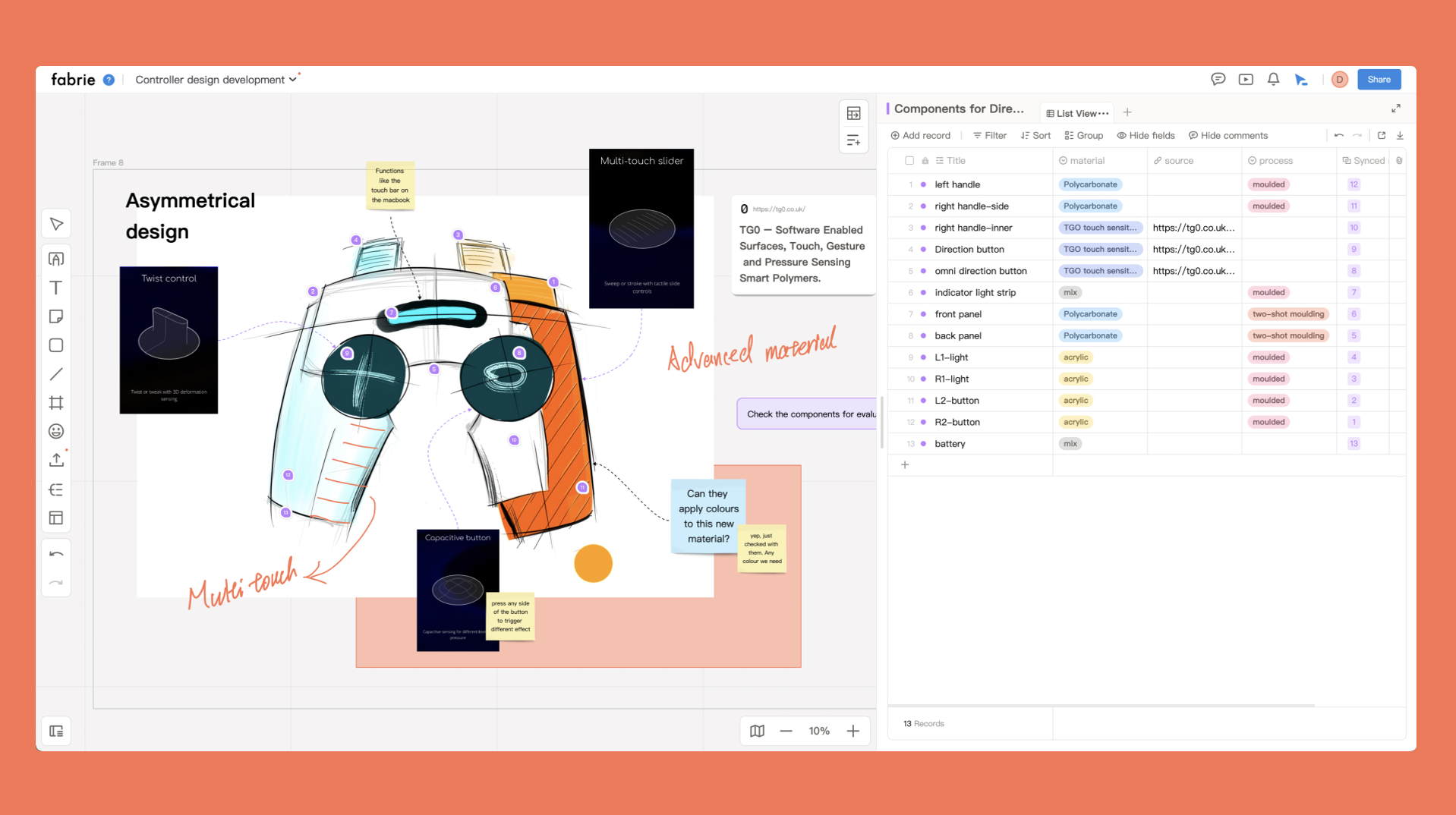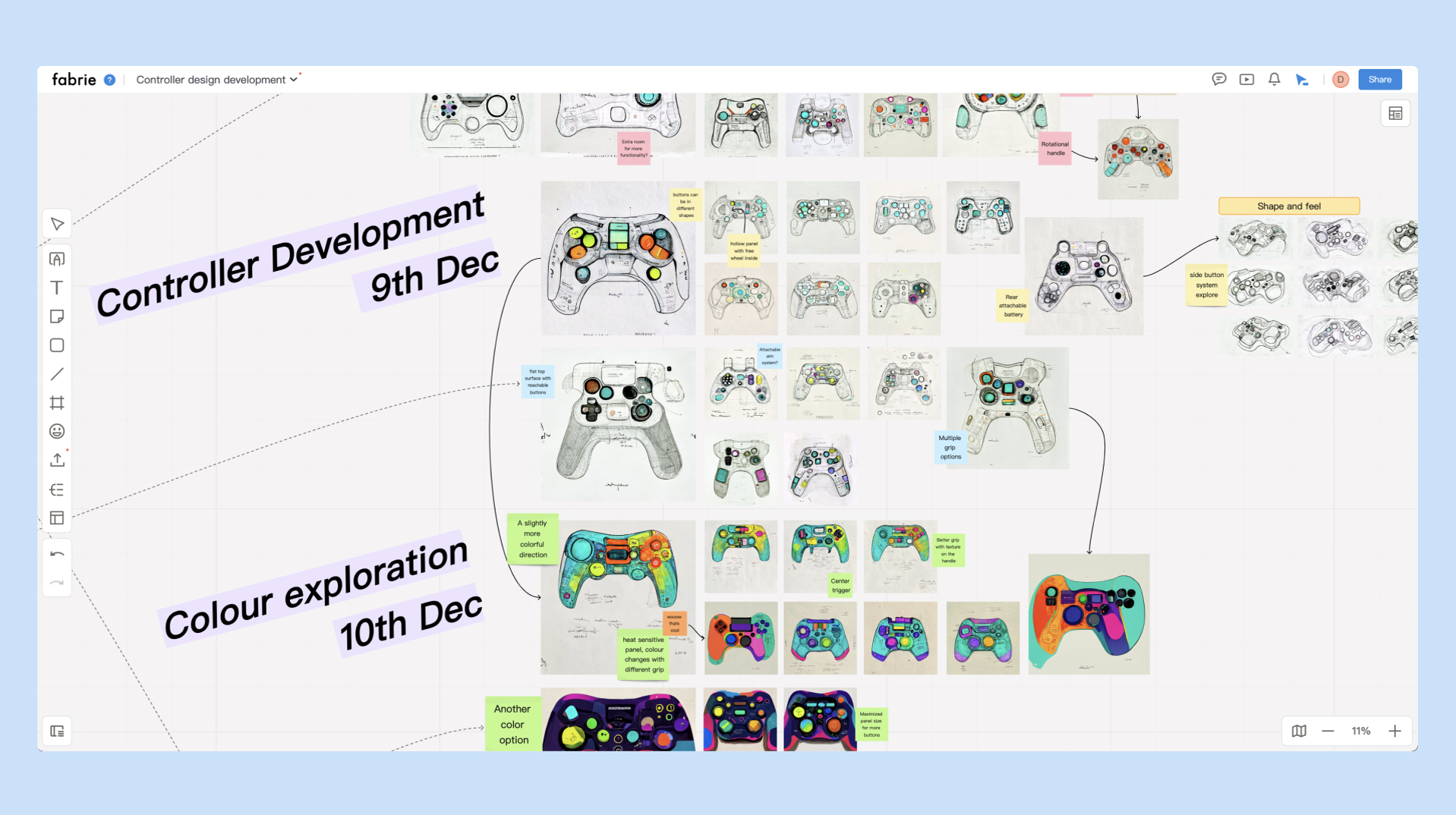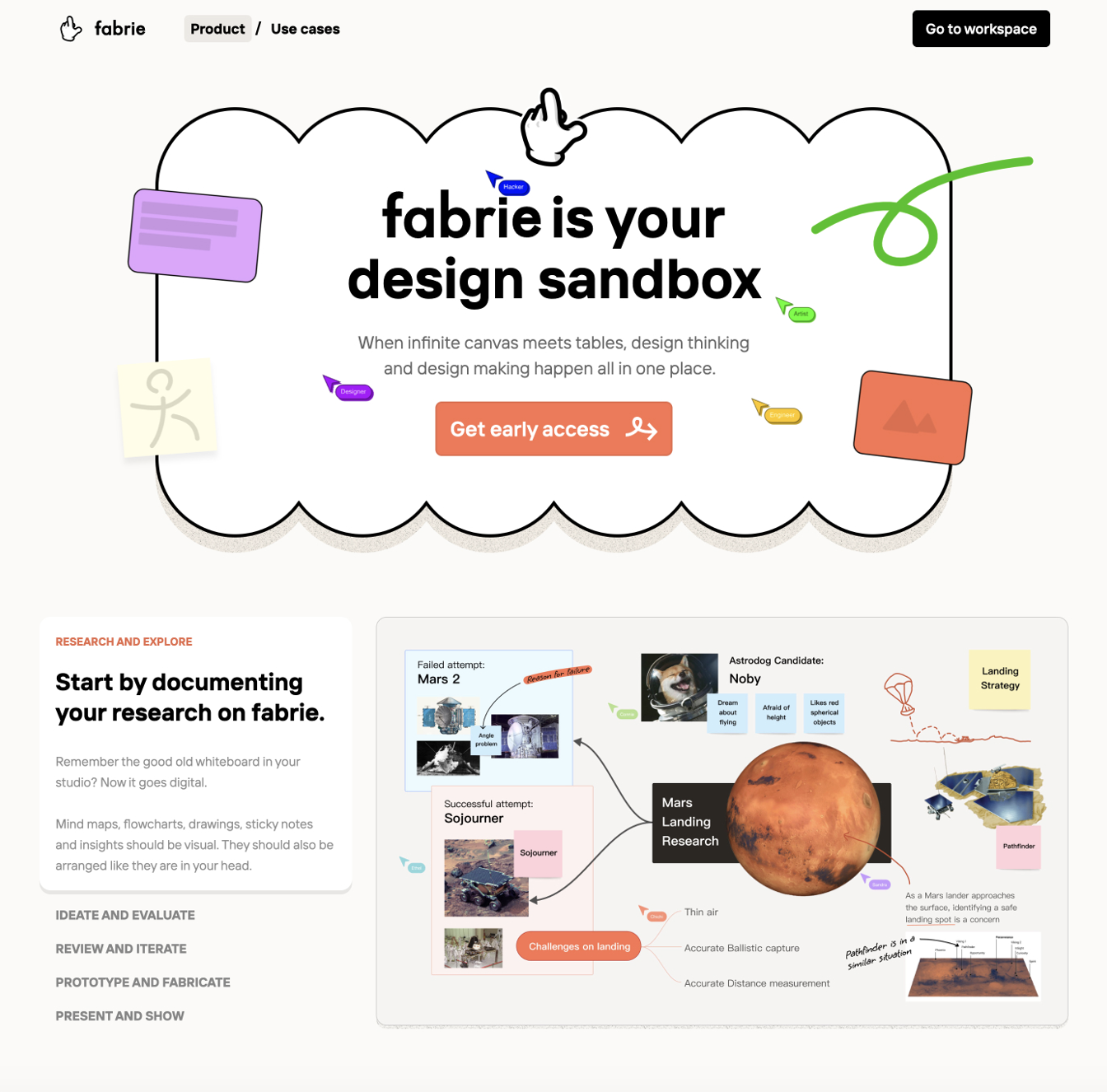36 Krypton learned that “Fabrie”, an online design collaboration tool for the global design market, has recently completed the Pre-A+ round of financing, which is another capital boost after the Pre-A round in March this year. This round was jointly led by CDH VGC Investment and Sequoia China Seed Fund, and the old shareholders Volcanic Stone Investment and BAI Capital also increased their investment. Cloud Bridge Capital acted as the exclusive financial advisor.
Founded in 2021, “Fabrie”, with “online whiteboard + multidimensional form” as its main product form, is a design collaboration platform for the global designer market, dedicated to helping more than 100 million designers from various sub-sectors around the world, and its upstream and downstream collaborators to better address diverse needs in a borderless space.
Globally, online whiteboarding tools are rapidly growing as an emerging “workplace”. Among them, the launch of FigJam even triggered Adobe’s $20 billion acquisition of Figma to a certain extent. Although whiteboard tools have existed for many years, with the expansion of vertical segmentation, the development of user habits, and the emergence of practical scenarios, it has only been two years since it became a mainstream remote office product, and the market growth space is very considerable. . Rapidly rising Miro, FigJam, etc. have become the focus of the collaboration field. Miro has grown from 5 million users to 40 million within two years.
“From the perspective of product form, the borderless online whiteboard can better solve the problems of limited physical whiteboard or desktop space in design work, limited content expression methods, and limited expressive power.”
“Fabrie” founder Dabo told 36 Krypton that when it comes to whiteboards, the public is more likely to think of mind mapping tools, but compared with such tools, whiteboard tools carry richer content and information forms, and are more effective in collaboration and interaction. More intuitive and convenient.
Dabo graduated from Central Saint Martins in London with a major in product design, and a postgraduate degree in innovative design and computer graphics from the Royal College of Art and Imperial College London. He has worked in London and Shanghai for many years in design. According to Dabo’s insight, roles within the design team are gradually “de-starring”. As the industry matures, the tendency for individuals to specialize in vertical domains also makes design collaboration within or across teams more important. At the same time, cross-industry disciplines also gave him a multiple perspective: how tools and technologies can solve the pain points of designers.
As one of the few online whiteboard products for vertical users, “Fabrie” can be regarded as “the virtual avatar of the wall covered with design drafts” in the design studio: it carries a design project from beginning to end All design documents and processes of , as well as the team’s lightweight database, will be shared with team members in a visual way. Traditional mind maps, notes, etc. are just one of the tools for carrying information, but what designers really need is a collaborative space where information exchange is more convenient and complete, and will not “drag inspiration”.
Online whiteboard + multi-dimensional form, focus on design collaboration
“However, design collaboration requires more than a whiteboard tool.”
Image credit: Fabrie
In the user survey before the launch of the project in 2020, Dabo found that designers and users often use Miro in combination with Notion and Airtable to make up for the lack of structured information carrying capacity of whiteboard tools, but the data is not interoperable and switching is low. Efficiency is also the main reason why many designer users are dissatisfied with online whiteboards.
Therefore, “Fabrie” takes “borderless whiteboard + multi-dimensional form” as the product form, and uses the capability of lightweight database to serve the design management and implementation links. In terms of product functions, “Fabrie” first considered the storage of design documents, combined with the pain points of traditional WeChat and network disk storage “shared but not intuitive”, and local storage “fast but not shared”, while realizing cloud sharing. When it comes to the intuition of “ignoring the file format”, it is like a wall in a real space, and can directly render design files in professional formats such as PS and AI, so that designers and non-designers can forget about it when looking at it Format issues, to achieve real-time and asynchronous sharing of information.
On the other hand, the value of design collaboration is based on the increasingly mature cognition of user habits. Today, a new generation of collaboration tools has subverted the collaboration and transmission concept of “local file” of office software such as Office Family Bucket and Adobe Family Bucket. From Notion to Airtable and Figma, product features such as link to file, multi-person real-time asynchronous collaboration, and mutual integration have gradually become popular, and the concept of cloud database and workspace is replacing office software.
In such an environment, many general-purpose tools have become more or less the same. For example, since Notion, collaborative documents have flooded in, but even if they have achieved good product precision, they will lack competitiveness because they do not present disruptive ideas or are not focused enough.
“The core barrier of “Fabrie” comes from the focus on the design scene. “
In Dabo’s view, the value of focus is undoubtedly huge. By introducing multi-dimensional tables like Airtable, a more vertical and professional design template market, and continuous launch of design-related plug-in tools (such as the recently launched AIGC function for internal testing, “Fabrie” has also become the first in China to introduce AIGC technology. Design whiteboard tools) will bring innovation and change to the new generation of design scenarios. The design collaboration tools in the form of whiteboards have the opportunity to integrate the AI capabilities of hundreds of schools into one, and use the powerful combination of tools to broaden the imagination of designers. Boundaries of power and expressiveness.
In addition, compared with other online whiteboard tools, “Fabrie” excludes dispensable general functions, making the product more targeted. For example, in terms of shortcut key design, graphic zooming interaction logic and other details, it has been adapted according to the usage habits cultivated by designers when using traditional design software.
On the other hand, overseas, even Miro, which is regarded as a benchmark product by “Fabrie”, has problems such as being too general and lacking support for core design scenarios, such as not supporting some professional format files, and lacking more structured Information management functions, etc.
In terms of industry Know-how, the design-focused professional template market corresponds to the demand scenarios naturally accumulated by “Fabrie” in the process of serving the design industry, which can not only bring obvious efficiency improvements to designers, but also reduce Practice the cost of design methodology to upgrade thinking. At present, “Fabrie” is already encouraging in-depth users to share their own case templates, and in the future, a designer community around templates will be formed.
Image credit: Fabrie
“Fabrie AI: Integrating AI into Workflow and Reshaping the Value Structure of Design Tools.”
As companies like Stability and OpenAI release newer, more powerful AI models to developers via APIs, 2022 is shaping up to be a high point for AIGC tools. Fabrie will also fully embrace the new era of artificial intelligence, integrating various AI functions into the design workflow.
At present, “Fabrie AI” has launched the function of generating pictures from text, and has been widely used in scenarios such as story boards, mood boards, concept maps, illustrations and poster production. In the future, Fabrie AI will launch more AI plug-ins or functions. By combining AI capabilities with conventional whiteboard and form editing capabilities, designers’ work efficiency can be improved and repetitive execution can be reduced.
Based on the global market + PLG model
“We have been committed to the global market since Day one.”
Dabo said, “Fabrie” launched the overseas version of fabrie.com shortly after the internal test of the desktop terminal. At the same time, based on the consideration of domestic users’ office and connection with the mainstream environment, the internal test version of the WeChat applet has just been launched.
Image credit: Fabrie
From the perspective of the entire design industry, the design workflow in the global market follows the basic framework of design thinking, especially in design industries that are highly related to manufacturing, such as product design and apparel design, where a natural global collaboration network already exists. There are not too high localization cultural barriers, so “Fabrie” as a collaboration tool naturally needs to serve the global market.
Combined with the characteristics of instrumentation, from the perspective of the entire domestic enterprise service field, online collaboration has always been one of the most promising tracks for running out of the PLG model. Since the official launch of “Fabrie” this year, the number of users has grown rapidly. In the past three months, it has maintained an average monthly growth rate of more than 30%. The average daily usage time of the top 10% of daily active users has reached 5-7 hours. Well done. “Fabrie” will launch a paid version early next year, divided into free version, team version and enterprise version.
In terms of team, “Fabrie” currently has nearly 40 team members with an average age of 27. The core members come from companies such as Alibaba, Byte, Baidu, and Ctrip, as well as Imperial College, Royal College of Art, New York School of Visual Arts, Duke , CAFA, Shanghai Jiao Tong, Fudan and other schools.
At present, “Fabrie” covers visual design, interaction design, industrial design, fashion design, architectural and space design and other industries. It goes deep into different fields to subdivide scenarios, weakens the communication barriers of design team collaboration, and makes information resource sharing smoother. Its user groups include world-renowned design companies, teachers and students of design schools, etc.
“Design is not only about designers, and design tools should not only serve designers.”
In the view of the “Fabrie” team, users in the Fabrie community are not only a group of designers who are tireless in solving design problems, dare to break through the boundaries, and have an experimental spirit, but also include upstream and downstream roles that work closely with designers, including Marketing, supply chain management, structural engineers, etc. In the future, “Fabrie” will further explore the needs and scenarios of different subdivided design industries, so as to improve the collaboration and management efficiency of design projects.
media reports
36Kr Entrepreneurship State Investment Community
related events
- “Fabrie” completed the Pre-A+ round of financing, led by CDH VGC Investment and Sequoia China Seed Fund2022-12-16
- The Chinese version of Figma “Pixso” completed nearly 100 million yuan in financing2022-03-28
- Online collaboration tool Fabrie documents received tens of millions of financing2022-03-24
- Laihua completes 266 million yuan in round C financing2021-10-28
- Microsoft Whiteboard whiteboard application on the App Store 2018-09-25
This article is transferred from: https://readhub.cn/topic/8lL2zF3kQ7r
This site is only for collection, and the copyright belongs to the original author.


